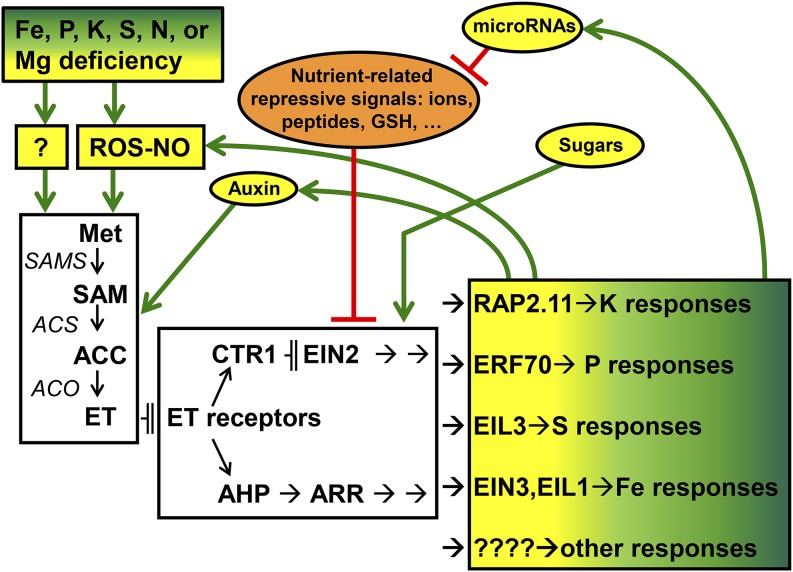Figure 4.
Working model to explain the role of ethylene (ET) on the regulation of responses to different nutrient deficiencies in plants. Nutrient deficiencies can enhance ET production by up-regulating SAMS, ACS, and ACO genes (Shin and Schachtman, 2004; García et al., 2010; Hermans et al., 2010), although the steps leading to this up-regulation are not yet clear. A possibility is that, at first, nutrient deficiencies cause oxidative stress and consequently, ROS accumulation and possibly, NO accumulation (Shin et al., 2005; Tewari et al., 2006; Graziano and Lamattina, 2007; Ahlfors et al., 2009; Jung et al., 2009; García et al., 2011; Iqbal et al., 2013; Steffens, 2014). This ROS-NO accumulation would stimulate ET production, which in turn, could increase ROS-NO production (Ahlfors et al., 2009; Jung et al., 2009; García et al., 2011; Iqbal et al., 2013) in a positive feedback loop, leading to enhancement of the nutrient deficiency signal (García et al., 2011). When ET is perceived by the receptors, it could act through a CTR1-EIN2-dependent pathway for the regulation of some responses or a CTR1-EIN2-independent pathway for the regulation of other responses (Fig. 3). At the end of these transduction pathways, different ET-related transcription factors, such as RAP2.11, ERF070, EIL3, EIN3/EIL1, or others, would activate different nutrient responses (Maruyama-Nakashita et al., 2006; Kim et al., 2012; Ramaiah et al., 2014; Yang et al., 2014). Under nutrient sufficiency, several signals that can move through the phloem (mineral ions, peptides, GSH, etc.; Lappartient et al., 1999; García et al., 2013; Zhang et al., 2014) could negatively interact with ET to inactivate nutrient responses. However, under nutrient deficiency, other signals that can move through the phloem (microRNAs, auxin, sugars, etc.; Kasajima et al., 2007; Lejay et al., 2008; Hammond and White, 2011; Lei and Liu, 2011; Hu et al., 2015) could positively interact with ET to activate the responses. Additionally, ET can influence auxin accumulation and distribution and the expression of some microRNAs (see text for details). Yellow background indicates signals that activate responses, orange background indicates signals that repress responses. AHP, Arabidopsis His Phosphotransfer; ARR, Arabidopsis Response Regulators; ─╢, inhibition; →, promotion.

